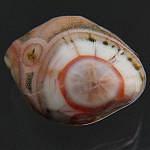|
Click on a letter above to view the list of gems. |
|
|
|
|
|
|
|
|
Thomsonite-Ca |
|
| Chemistry: NaCa2Al5Si5O20·6(H2O) | |
| Discovered
in 1820;
IMA
status: Valid (pre-IMA; Grandfathered). | ||
|
| ||
|
Classification |
|
|
| |
|
Silicates | |
|
|
8 : Silicates |
|
|
|
|
Crystal Data |
|
|
|
|
|
Commonly prismatic, acicular, or bladed, flattened, elongated and striated, to 12 cm; in radiated spherical or columnar aggregates; smooth, globular, botryoidal; compact, massive. Twinning: On [110]. |
|
|
|
|
|
Physical Properties |
|
|
|
|
|
[101] Perfect, [100] Good |
|
|
Uneven, Conchoidal, Subconchoidal |
|
|
Brittle |
|
|
5.0 - 5.5 |
|
|
2.30 - 2.40 (g/cm3) |
|
|
Not Radioactive |
|
|
|
|
|
Optical Properties |
|
|
|
|
|
Colorless, White, Greenish, Yellow, Pink; may be concentrically zoned |
|
|
Transparent to Translucent |
|
|
Vitreous (Glassy), Pearly |
|
|
1.511 - 1.545 Biaxial ( + ) |
|
|
0.0050 - 0.0150 |
|
|
Dispersion distinct to strong, r > v |
|
|
Colorless |
|
|
|
|
|
Occurances |
|
|
|
|
|
Geological Setting: |
Found in amygdules and fractures in maffic igneous rocks, typically basalts; in some alkalic igneous rocks, contact metamorphic zones, and hypabyssal rocks. As an authigenic cement in some sandstones. |
|
Type Locality: |
Old Kilpatrick, Strathclyde (Dunbartonshire), Scotland, UK |
|
Year Discovered: |
1820 |
|
View mineral photos: | |
|
|
|
|
More Information |
|
|
|
|
|
| |
|
|
|
|
Thomsonite can be found in many locations worldwide but only few produce good crystal specimens and even fewer produce the beautiful and colorful concentric "eye" patterns like those found in the western Lake Superior area; Isle Royal and the Keweenaw Peninsula in Michigan and the Grand Marais, Minnesota area. Pure
Thomsonite is snow-white and sometimes translucent;
very, very rarely suitable for faceting. Impurities
such as ferric
and/or ferrous iron or copper are responsible for the
various colorations within the mineral. Commonly found
colors are pink, tan, white, red and brown. Those with
green, gray or black backgrounds or green eyes are the
most highly prized but rarely found. These concentric,
colorful eye patters make beautiful cabochons. |
|
|
|||||||||||||||||||||||||||


